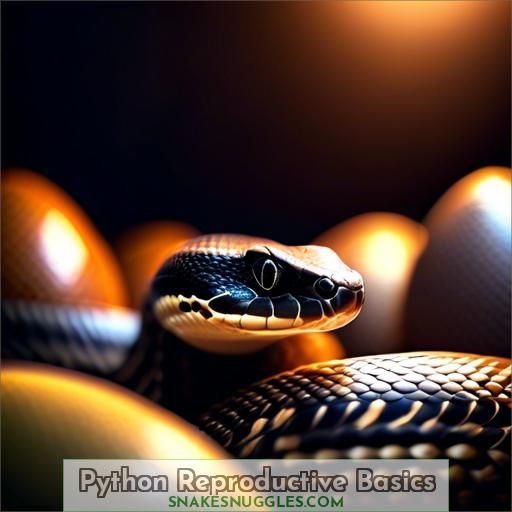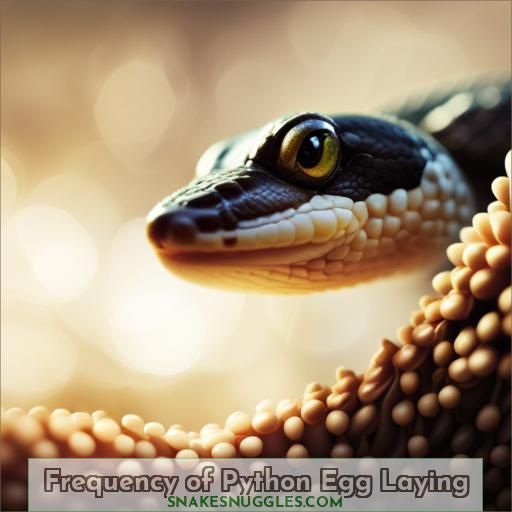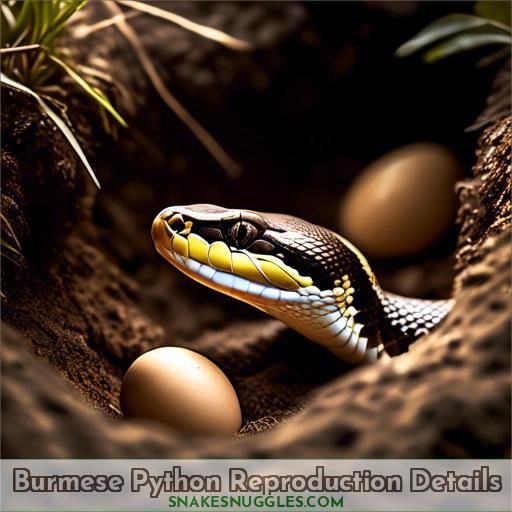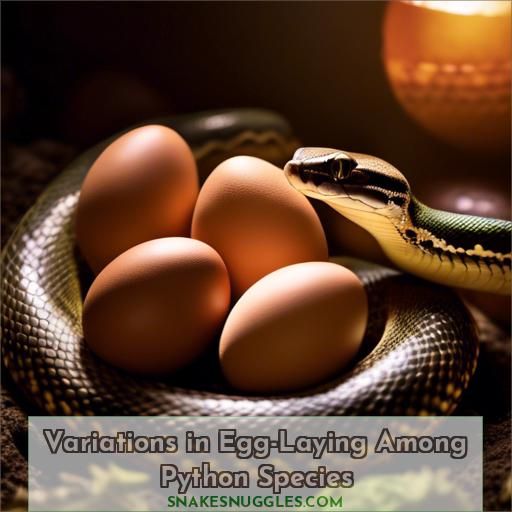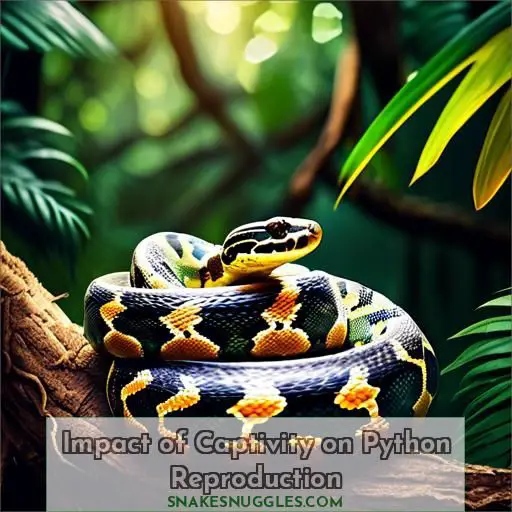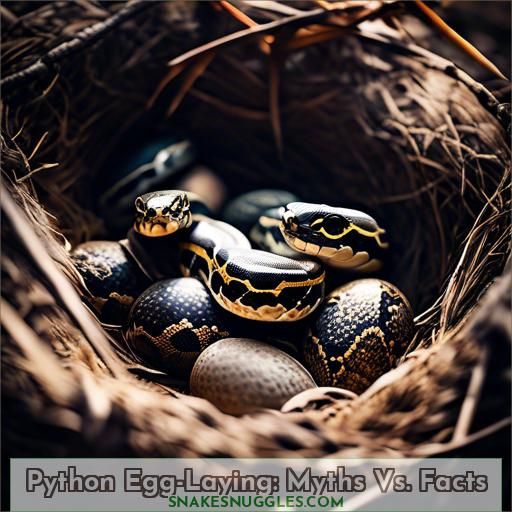This site is supported by our readers. We may earn a commission, at no cost to you, if you purchase through links.
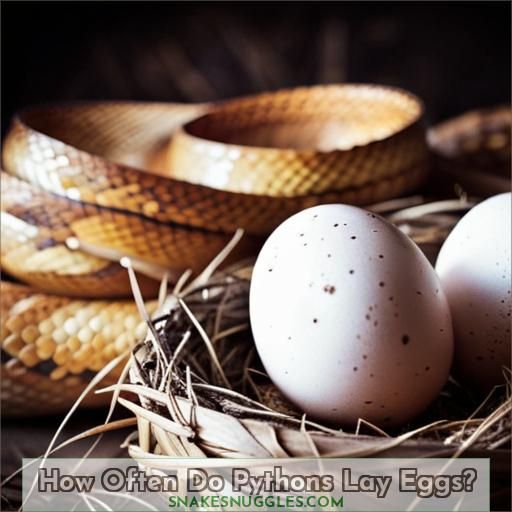
The frequency of python egg-laying varies greatly across species and individuals.
Most pythons lay eggs only once or twice a year, although some may not lay any for years between clutches.
Age, size, health, and environmental factors affect how often a year pythons lay eggs. For instance, younger or smaller snakes may reproduce less often.
Proper nutrition and ideal conditions support regular egg production cycles.
However, the details of their intriguing reproductive rhythms are subtle; to truly reveal nature’s precision, further investigation is necessary.
Table Of Contents
- Key Takeaways
- How Many Times a Year Do Pythons Lay Eggs?
- Python Reproductive Basics
- Frequency of Python Egg-Laying
- Factors Influencing Egg-Laying Frequency
- Ball Python Egg-Laying Patterns
- Burmese Python Reproduction Details
- Maternal Care in Pythons
- Variations in Egg-Laying Among Python Species
- Impact of Captivity on Python Reproduction
- Python Egg-Laying: Myths Vs. Facts
- Frequently Asked Questions (FAQs)
- Conclusion
Key Takeaways
- Pythons typically lay eggs once or twice a year, although some may not lay any for years between clutches.
- Age, size, health, and environmental factors affect how often a year pythons lay eggs.
- Python eggs are substantial and exhibit considerable variation in size.
- Proper nutrition and ideal conditions support regular egg production cycles.
How Many Times a Year Do Pythons Lay Eggs?
Pythons lay eggs once a year on average, but the exact number of eggs laid can vary. For example, ball pythons can lay anywhere from 3 to 16 eggs in one reproductive cycle, with an average clutch size of around seven eggs in captivity. Reticulated pythons, on the other hand, can produce 8-107 eggs in a breeding year, with an average of 25-50 eggs.
Python Reproductive Basics
Welcome to the intriguing realm of python egg-laying! As a python aficionado, you’re probably eager to delve into the intricacies of these captivating creatures’ reproductive process. Let’s embark on a journey to explore the fundamentals of python egg-laying, focusing on python egg dimensions, viability, predators, evolution, acquisition, and incubation.
Python eggs are substantial and exhibit considerable variation in size, with certain species producing eggs as large as a human head. The viability of python eggs is paramount, as it dictates the survival of the hatchlings. Predators, such as raccoons and birds, pose a threat to python eggs, rendering incubation a critical stage in the reproductive process.
Python egg evolution is a intricate process that involves the growth and maturation of the embryo within the egg. This process is influenced by factors such as age, maturity, health, nutrition, and environmental conditions. Python egg acquisition is an essential component of conservation efforts, as it enables the study and protection of these endangered species.
Incubation is the period during which the eggs are maintained at specific temperatures and humidity levels to foster proper embryonic development. This stage is crucial for the hatchling’s survival, as it determines the reproductive capacity of the python.
As a python owner or enthusiast, comprehending the fundamentals of python egg-laying can enhance your appreciation of the complexities of these creatures’ reproductive process. So, let’s continue our exploration of the fascinating world of python reproduction!
Frequency of Python Egg-Laying
Python species, such as Burmese and ball pythons, lay eggs in clutches**. The number of clutches laid annually varies between species and individuals. Burmese pythons can lay up to 100 eggs at a time, while ball pythons can lay between 3 and 16 eggs per reproductive cycle. The frequency of egg-laying is influenced by factors such as age, health, and environmental conditions.
Python species exhibit maternal care during the egg-laying process. Female pythons coil around their eggs to maintain warmth and protect them from predators. After hatching, the mother leaves her offspring to fend for themselves.
Invasive species like the Burmese python pose a threat to native species in their ecosystems. Efforts to remove these invasive species from the wild are ongoing, with events like the Florida Python Challenge encouraging participation from both professionals and novices.
Python eggs are a valuable resource in the pet trade, and understanding the factors that influence their growth and development can help biologists monitor and manage populations of these cryptic, endangered, and invasive species.
Factors Influencing Egg-Laying Frequency
Several key factors influence the frequency with which pythons lay eggs.
A python’s age, size, and overall health play a significant role.
Environmental conditions like temperature, humidity, and the availability of suitable nesting sites also play a role.
Proper nutrition is essential too.
Well-nourished pythons are more likely to reproduce regularly.
Those lacking essential nutrients may experience disruptions in their egg-laying cycles.
Age and Maturity
As pythons slither through the tapestry of life, age and maturity are the weavers of their reproductive tapestry.
In the wilds of Florida’s ecosystem and the lush habitats of Southeast Asia, stress and genetics play tug-of-war with behavior, influencing when these serpentine sovereigns decide to grace the earth with their progeny.
It’s a delicate dance of care and timing, where experience matters.
Health and Nutrition
As a python enthusiast, you’re likely aware that the well-being and sustenance of these fascinating creatures play a pivotal role in their reproductive behavior. The evolution of pythons has been molded by their environment, and understanding their habitat is essential to maintaining their health and guaranteeing successful reproduction.
Pythons, like many reptiles, are oviparous, meaning they lay eggs for reproduction. Their reproductive cycle is influenced by both seasonal and environmental factors. In the case of ball pythons, females typically lay eggs during the spring and summer months, a time when food is plentiful and environmental conditions are ideal for incubation.
In the wild, pythons seek out appropriate nesting sites, such as abandoned rodent burrows or leaf litter, to deposit their eggs. These sites provide the necessary warmth and protection for successful incubation. In captivity, it’s paramount to imitate these natural nesting conditions to facilitate egg deposition. Providing a hide box with a suitable substrate can help replicate the desired nesting environment.
The health of pythons is intricately linked to their nutrition. A balanced diet is indispensable for their overall well-being and reproductive success. In the wild, pythons consume a variety of prey, including birds, mammals, and other reptiles. In captivity, they’re typically fed a diet of rodents, such as mice or rats.
Conservation efforts play a critical role in maintaining the health and population of pythons. By comprehending their reproductive biology and behavior, we can implement effective conservation strategies to safeguard these magnificent reptiles and ensure their persistence in the wild.
Environmental Conditions
Environmental conditions play a pivotal role in the egg-laying frequency of pythons. Here are three key aspects to contemplate:
- Temperature: Pythons require specific temperature ranges for egg incubation and hatching.
- Humidity: High humidity is essential for maintaining proper moisture levels in the eggs and the surrounding environment.
- Seasonality: Seasonal changes can influence the timing of egg-laying and the success of hatching.
Grasping these environmental factors can help us better appreciate the intricate reproductive biology of these captivating creatures.
Ball Python Egg-Laying Patterns
As a breeder, comprehending the egg-laying patterns of your ball python is paramount for effective breeding. Ball pythons can deposit anywhere from 3 to 16 eggs in a single reproductive cycle, with an average clutch size of around seven eggs in captivity. The dimensions of the eggs and the clutch may fluctuate based on the female’s size and maturity.
The egg size and clutch spacing are significant factors to account for when preparing for the breeding season. A larger female will typically lay larger eggs, and the eggs will be spaced further apart in the clutch. The incubation period for ball python eggs is usually around 60 to 70 days, with hatching success varying based on the environmental conditions.
When preparing for the breeding season, it’s imperative to ensure that the female is provided with proper care and adequate nourishment while gravid. This includes providing a suitable egg-laying site, such as a small box packed with damp peat moss, and maintaining the temperature in the tank within the range of 95-100°F.
Bear in mind that females won’t eat while incubating, so it’s crucial to consider the female’s size and age before allowing her to incubate her own eggs. Maternal incubation may be a more suitable option for snakes older than four years and heavier than 1,800 grams.
Burmese Python Reproduction Details
As we explore the complexities of Burmese python reproduction, it’s essential to recognize the factors that shape their egg-laying patterns. Burmese pythons usually lay their eggs every two to three years, but this interval can be influenced by age, health, and environmental conditions. For example, younger pythons may lay eggs more frequently as they approach maturity, while older females may lay fewer eggs due to age-related decreases in fertility. Furthermore, pythons in poor health or those with inadequate nutrition may also lay fewer eggs or produce eggs with lower viability.
Burmese pythons exhibit a wide range of egg-laying behaviors, with some females laying as few as 10 eggs and others producing up to 50 eggs per clutch. This variability in egg-laying is influenced by factors such as habitat availability, climate change, and the presence of invasive species. For instance, habitat loss due to human activities or natural disasters can reduce the number of suitable nesting sites, resulting in lower egg-laying frequencies. Similarly, climate change can affect the availability of suitable nesting sites and the viability of eggs, as warmer temperatures can lead to increased predation and reduced hatching success.
Invasive species, such as the Burmese python, can also have a substantial impact on the egg-laying frequency of native species. These invasive pythons can hunt the eggs and hatchlings of native species, reducing their population size and potentially leading to a decline in egg-laying frequencies.
Maternal Care in Pythons
After laying their eggs, female pythons exhibit remarkable maternal care by coiling their bodies around the clutch to maintain ideal temperatures for incubation. This brooding behavior continues even after the eggs hatch, providing warmth and protection to the vulnerable hatchlings as they complete the process of digesting their remaining egg yolk reserves.
Egg Incubation
Continuing from the intimate dance of Burmese python reproduction, let’s explore the heart of egg incubation. These serpentine mothers are masters of thermal regulation, tightly coiling around their clutches. This isn’t just a warm embrace; it’s an evolutionary adaptation ensuring yolk digestion and hatchling vigor. Amidst climate change, could this cooperative care be nature’s way of ensuring survival?
Post-Hatching Care
Post-hatching care is essential for the survival of python hatchlings.
Mothers exhibit parental care by coiling around eggs to maintain warmth, turning black to absorb sunlight, and providing a secure nesting site.
However, undigested egg yolk can make snakelets susceptible, and mothers may lose up to 40% of their body weight during child-rearing.
Some mothers even starve after bearing children.
Pythons lay clutches every two to three years, and the advantages of maternal care outweigh the disadvantages.
Variations in Egg-Laying Among Python Species
Python species exhibit a range of reproductive strategies and regional variations in egg-laying behavior. The frequency and timing of egg-laying can be influenced by factors such as age, health, nutrition, and environmental conditions. For instance, royal pythons lay eggs on average every two to three years, while ball pythons may lay eggs more frequently, depending on their size and condition.
In the case of Burmese pythons, their egg-laying patterns are influenced by ecological factors. Females lay eggs in the wild during the rainy season, primarily from mid-September through mid-November. In captivity, they can be bred throughout the year, provided the environmental factors are managed properly.
The number of eggs laid by a female python can also vary. For example, royal pythons lay an average of 6.5 eggs, with a range from 1 to 11. This variability can be attributed to factors such as the female’s age, health, and nutritional status, as well as the specific environmental conditions in which she’s housed.
Conservation implications of these variations in egg-laying frequency and timing are significant. Understanding the reproductive strategies of different python species can help inform conservation efforts, such as breeding programs in captivity, which can contribute to the preservation of these species in the wild.
Impact of Captivity on Python Reproduction
As we explore the complexities of python reproduction, it’s pivotal to comprehend how captivity can affect their reproductive well-being.
Captive pythons often encounter stress from unfamiliar surroundings, dietary alterations, and hormonal imbalances. These elements can sway their egg-laying regularity and quality.
Space and temperature are also paramount considerations, as pythons necessitate specific environmental parameters to procreate and lay eggs.
In the wild, they possess the discretion to select the ideal nesting site, but in captivity, these conditions are frequently unfulfilled.
This may result in diminished fertility and a reduction in the quantity of eggs laid.
It’s imperative to provide captive pythons with optimal care to safeguard their reproductive health and general well-being.
Python Egg-Laying: Myths Vs. Facts
Let’s crack the shell on some python egg-laying myths, shall we? You might think all python eggs are carbon copies, but nature’s not that bland.
Python egg size can be as varied as the pythons themselves, with some resembling mini footballs and others more like a plump grape.
And while most python clutches are decked out in classic off-white, don’t be surprised by a palette of egg color variations, hinting at a snake’s diet or abode.
Seasonal influences and geographic variations also play party planners, dictating as far as pythons throw their egg-laying shindigs.
So, remember, when it comes to clutch size differences, it’s not a one-size-fits-all affair—nature loves a bit of spice!
Frequently Asked Questions (FAQs)
How many times do pythons lay eggs in a year?
You got it, pal! Pythons typically lay eggs every 2-3 years, so yearly egg-laying is a rarity. But when they do get frisky, watch out – a single clutch can have up to 100 eggs, creating a snake nursery!
What factors influence the frequency of python egg-laying?
You’ll find that python egg-laying frequency hinges on factors like species, climate, and resource availability. In general, these reptilian mamas lay clutches every 2-3 years – a metabolically taxing feat requiring prime conditions.
How long does it take for python eggs to hatch after being laid?
You’re on the edge of your seat, aren’t you? Well, the suspense for python egg incubation is around 60-80 days on average. But it varies based on species and environmental factors – keep an eye out for those newly hatched snakelets!
Can python eggs be candled for viability testing?
You bet! Candling python eggs is a surefire way to check for viability. Just shine a bright light through the shell – if the embryo’s developed, you’ll see red veins. Do it weekly to monitor progress until the neonates pip. It’s an eggciting process!
What is the average clutch size for ball pythons in captivity?
Similar to the forbearance of a skilled artisan, ball pythons in captivity methodically deposit egg clutches averaging 6-12 eggs each year. This strategic reproductive approach guarantees a predictable, premium-quality yield of offspring for committed reptile aficionados.
Conclusion
Unraveling nature’s complex fabric, the mesmerizing cycles of python egg-laying reveal a symphony of factors governing their reproductive abilities.
From the enigmatic influence of age and maturity to the delicate interplay of environmental conditions, you’ve explored the core of this phenomenon.
Uncovering the frequency with which these serpentine wonders typically lay eggs.
Embrace the wisdom gained, for it sheds light on the intricate sphere where life perpetuates its wondrous cycle.

